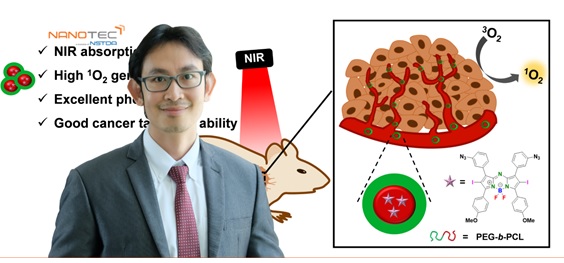At the recent Thailand Inventors’ Day 2021-2022 hosted by the National Research Council of Thailand (NRCT), several NRCT awards were announced. Among the works honored by the awards were “Organic Zinc ion Disinfectant Product” for NRCT Invention Award and “Aza - BODIPY Encapsulated Polymeric Nanoparticles As an Effective Nanodelivery System for Photodynamic Cancer Treatment” for NRCT Research Award.
Organic Zinc ion Disinfectant Product
Dr. Warayuth Sajomsang, Principal Researcher of Nanohybrids and Coating Research Group explained that the research team at NANOTEC and BIOTEC was set out to develop a zinc ion-based antimicrobial product to replace the use of antibiotic drugs and other toxic antibacterial chemicals.

Antibiotics have been used routinely in farm animals in Thailand in order to prevent and control common disease events, and to enhance animal growth. The use is extensive and worth approximately THB 10 billion annually. The excessive use of antibiotics causes global public health concern as it leaves antibiotic residues in food products and creates superbugs. Strict regulations have been imposed in a number of countries to restrict antimicrobials usage in livestock and limit the amount of antibiotic residue in meat, and gravely affected Thai meat exports businesses.
Zinc ions are known to exhibit a broad-spectrum antimicrobial activity against both gram-positive and gram-negative bacteria. The technology developed by NSTDA research team involved the use of chelating and stabilizing additives to boost antibacterial and antiviral activities of zinc ion. The technology has been transferred to Unisil Group Company Limited. This zinc ion-based product has been registered with the Thai FDA as a control animal feed.
Realizing that the application of zinc ion can extend beyond animal feed, the technology has been applied to develop a zinc ion-based disinfectant product which has met the safety standards of Thai FDA.
Aza - BODIPY Encapsulated Polymeric Nanoparticles As an Effective Nanodelivery System for Photodynamic Cancer Treatment
Dr. Kantapat Chansaenpak, Researcher of Responsive Materials and Nanosensor Research Group, explained this innovative treatment for cancer. Photodynamic therapy combines light energy with a drug (photosensitizer) to kill cancer cells. The procedure involves administration of a photosensitizing agent followed by irradiation. After light activation, the photosensitizer converts oxygen to reactive oxygen species which are toxic to cancer cells. The nanoparticles developed from this work have been shown to inhibit breast cancer cell growth.

A prototype camera to capture fluorescent-dye cells in a lab mouse based on results of this study is being developed under the collaboration with Assist. Prof. Anyanee Kamkaew of Suranaree University of Technology.
In addition, two NANOTEC researchers received NRCT Dissertation Awards. Dr. Kanokwan Sansanaphongpricha was honored for her work on “NanoJanus and Nanosatellite Assembly for Biomolecular Delivery and Cancer Therapeutics” and Dr. Sirapassorn for “Effect of the External Magnetic Field on Carbon Dioxide Hydrogenation Over Iron and Copper Loaded on MCM-41
Mesoporous Silica Catalysts”.
